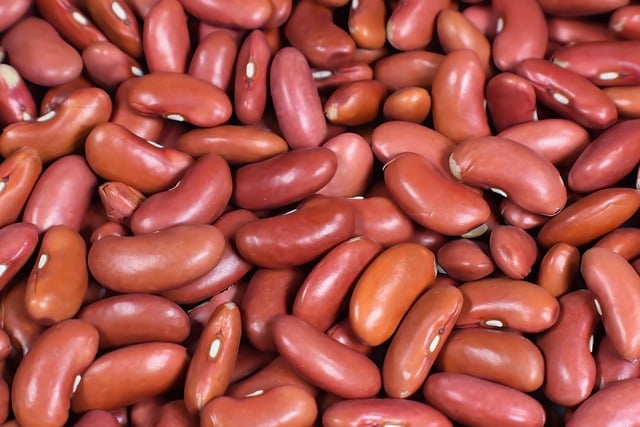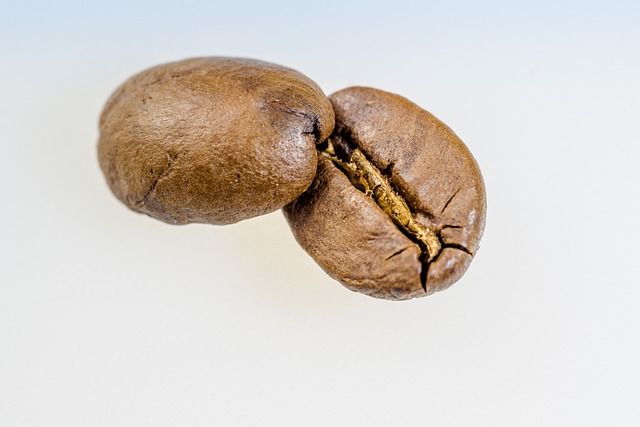Kidney beans are a nutrient-dense choice for those on a plant-based diet, rich in protein, fiber, iron, potassium, and magnesium. They offer significant health benefits including cholesterol reduction, blood sugar control, and support for heart health. To maximize these advantages, soak kidney beans overnight to improve digestibility and reduce anti-nutrients before cooking in fresh water with a pinch of salt. Their versatility allows them to be seasoned and incorporated into various dishes, from savory stews to refreshing salads. For those looking to preserve kidney beans for extended periods, home canning or drying methods are effective, ensuring access to these healthful legumes throughout the year. Proper preparation is key to reaping the full spectrum of kidney bean health benefits, making them a vital component for sustained energy and overall well-being within a plant-based meal plan.
Embark on a culinary journey to master the art of cooking kidney beans with our comprehensive guide tailored for beginners. Kidney beans, a nutritious powerhouse, offer an array of health benefits that make them an ideal addition to any diet, particularly for those following a plant-based lifestyle or seeking to manage blood sugar levels. This article delves into the various types of kidney beans, their distinct flavors, and how to prepare them in ways that enhance their nutritional value while maintaining optimal texture. From basic cooking techniques like boiling and steaming to advanced tips on maximizing fiber content and pairing with grains for a complete meal, we cover all aspects of incorporating these versatile legumes into your daily cuisine. Discover how kidney beans can contribute to heart health, weight management, and even the management of chronic diseases, all while being delicious and easy to prepare. Join us as we explore the countless ways to make kidney beans a staple in your kitchen, ensuring both culinary delight and dietary well-being.
- Mastering Kidney Beans: A Beginner’s Guide to Perfect Beans
- The Nutritional Advantages of Kidney Beans and Their Role in a Healthy Diet
- Understanding Kidney Beans: Varieties and Their Distinct Flavors
- How to Prepare Kidney Beans: Step-by-Step Instructions for Canning and Drying
Mastering Kidney Beans: A Beginner’s Guide to Perfect Beans

Embarking on your culinary journey with kidney beans can be a rewarding experience, as these legumes offer not only a versatile flavor profile but also significant health benefits. Kidney beans are a staple in many diets worldwide due to their high protein content, which is particularly beneficial for those following a plant-based diet. They are an excellent source of cholesterol-lowering fiber and are rich in vital nutrients such as iron, potassium, and magnesium. Including kidney beans in your meals can aid in blood sugar control, making them a suitable option for diabetes management or those watching their glycemic index.
To cook kidney beans to perfection, start by rinsing them thoroughly under running water to remove any dirt or impurities. Soaking the beans overnight can reduce cooking time and make them easier to digest. After soaking, drain the water and place the beans in a large pot with fresh water. Bring to a boil, then reduce the heat to a simmer. Adding a pinch of salt after the initial boil helps to maintain the beans’ firm texture while infusing them with flavor. Cook until they are tender but not mushy, as this will ensure they retain their shape and are pleasantly textured when incorporated into various dishes. Seasoning can be adjusted according to the desired recipe, whether it’s a hearty chili, a traditional stew, or a vibrant salad. The health benefits of kidney beans are maximized when cooked properly, allowing for full absorption of their nutrients and making them a valuable addition to any plant-based diet.
The Nutritional Advantages of Kidney Beans and Their Role in a Healthy Diet

Including kidney beans in your diet offers a multitude of health benefits, making them a staple for those looking to enhance their nutritional intake. These legumes are rich in protein and fiber, which contribute to the feeling of fullness and can aid in weight management. They’re also low in fat and free of cholesterol, which is excellent news for individuals watching their cardiovascular health. Kidney beans have a notable impact on blood sugar control due to their low glycemic index, which means they release glucose slowly into the bloodstream. This can be particularly advantageous for those with diabetes or those aiming to maintain stable blood sugar levels. Moreover, kidney beans are packed with essential nutrients like iron, potassium, and B vitamins, all of which support overall health. For those adhering to a plant-based diet, incorporating kidney beans into meals provides a valuable source of protein that can help replace animal proteins without compromising on flavor or satiety. When cooked properly, kidney beans offer a versatile and nutritious addition to any healthy diet, contributing to heart health, digestive health, and providing sustained energy throughout the day. How to cook kidney beans effectively involves soaking them overnight to reduce anti-nutrients like phytates, which can interfere with nutrient absorption, and then boiling them until tender. This preparation process not only enhances their digestibility but also preserves their health-promoting properties, ensuring that they’re a beneficial part of a balanced meal plan.
Understanding Kidney Beans: Varieties and Their Distinct Flavors

Kidney beans are a versatile and nutritious legume that offer a variety of health benefits, particularly for those following a plant-based diet. They are an excellent source of protein, fiber, and complex carbohydrates, which contribute to blood sugar control and heart health. The health benefits of kidney beans are further accentuated by their low-fat content and minimal cholesterol, making them a heart-healthy option for inclusion in a balanced diet.
When it comes to selecting kidney beans for your culinary endeavors, there are several varieties, each with its distinct flavor profile. The most common types include red, light red, dark red, and white kidney beans. Red kidney beans, rich in anthocyanin pigments, often have a nuttier taste and can range from a ruby hue to a deep, purple-black color. Light red kidney beans, on the other hand, boast a milder flavor and a creamier texture when cooked, making them a favorite for many recipes. Dark red kidney beans combine the best of both worlds in terms of flavor and texture, offering a balance that can stand up to bold spices without overpowering delicate dishes. Lastly, white kidney beans, also known as cannellini beans, have a slightly sweet taste and a firmer consistency after cooking, which can be delightful in salads and soups. Each variety’s distinct flavor makes them suitable for a range of recipes and dietary needs, from simple side dishes to complex main courses that align with a plant-based diet. Understanding these nuances allows you to choose the most appropriate type for your ‘How to Cook’ exploration, ensuring that you harness their full potential in your kitchen.
How to Prepare Kidney Beans: Step-by-Step Instructions for Canning and Drying

Incorporating kidney beans into your diet is a wise choice for those looking to reap the health benefits associated with plant-based foods. These legumes are not only rich in cholesterol-lowering fiber but also provide an array of vital nutrients that contribute to blood sugar control. To ensure that you can enjoy these benefits year-round, learning how to preserve kidney beans through canning and drying is invaluable.
Begin by properly preparing the kidney beans for canning or drying. Start by sorting through your beans to remove any shriveled or damaged ones. Rinse them thoroughly under running water to remove any dirt or debris. For canning, soak your kidney beans in enough water to cover them for at least four hours, or overnight for optimal texture and to reduce cooking time. This not only softens the beans but also helps to break down some of the complex sugars, making them easier to digest. After soaking, drain the beans and place them in a large pot. Cover them with fresh water, bringing the mixture to a boil. Once boiling, reduce the heat to a simmer and let the beans cook until they are tender, which can take anywhere from one to three hours depending on their age and size. As they soften, skim off any foam or impurities that rise to the surface.
Once the beans are fully cooked, they can be prepared for either drying or canning. For canning, pack the hot beans into sterilized jars, leaving about an inch of headspace at the top. Cover the beans with fresh, boiling water, ensuring that the liquid completely covers the beans. Seal the jars tightly and process them in a boiling-water canner for 75 to 90 minutes, depending on your altitude. Allow the jars to cool, undisturbed, for twelve hours. Check for a proper seal before storing the canned kidney beans in a cool, dark place.
For drying, allow the beans to cool after cooking. Then, spread them out in a single layer on a baking sheet or a drying rack and place them in a well-ventilated area away from direct sunlight. The goal is to dry them to a point where they are pliable but not so hard that they break when bent. Once dried, store the beans in an airtight container in a cool, dark place where they can last for up to a year. Whether canned or dried, these preserved kidney beans will be a testament to the convenience and longevity of home-preserved foods, allowing you to savor their health benefits far beyond the harvest season.
Embarking on a journey to incorporate kidney beans into your culinary repertoire is a rewarding endeavor. This guide has illuminated the nutritional advantages of these legumes, particularly their role in supporting heart health by managing cholesterol levels and aiding in blood sugar control, making them an excellent addition to a plant-based diet. With a variety of kidney bean types to explore, each offering its own unique flavor profile, you’re now equipped with the knowledge to prepare these beans to perfection, whether through canning for convenience or drying for long-term storage. Embrace the versatility and health benefits of kidney beans as you expand your cooking horizons beyond the basics. Happy cooking!



